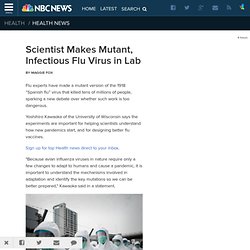

Frozen Giant Virus Still Infectious After 30,000 Years. It's 30,000 years old and still ticking: A giant virus recently discovered deep in the Siberian permafrost reveals that huge ancient viruses are much more diverse than scientists had ever known.

They're also potentially infectious if thawed from their Siberian deep freeze, though they pose no danger to humans, said Chantal Abergel, a scientist at the National Center for Scientific Research at Aix-Marseille University in France and co-author of a new study announcing the discovery of the new virus. As the globe warms and the region thaws, mining and drilling will likely penetrate previously inaccessible areas, Abergel said. "Safety precautions should be taken when moving that amount of frozen earth," she told Live Science. How Safe Is Your Ground Beef? Given those concerns about the safety of ground beef, Consumer Reports decided to test for the prevalence and types of bacteria in ground beef.

We purchased 300 packages—a total of 458 pounds (the equivalent of 1,832 quarter-pounders)—from 103 grocery, big-box, and natural food stores in 26 cities across the country. We bought all types of ground beef: conventional—the most common type of beef sold, in which cattle are typically fattened up with grain and soy in feedlots and fed antibiotics and other drugs to promote growth and prevent disease—as well as beef that was raised in more sustainable ways, which have important implications for food safety and animal welfare.
At a minimum, sustainably produced beef was raised without antibiotics. Even better are organic and grass-fed methods. Organic cattle are not given antibiotics or other drugs, and they are fed organic feed. The results were sobering. Just 1 percent of our samples contained salmonella. Kuru: The Science and The Sorcery. The Trouble with Antibiotics. Superbugs Killing Thousands of Newborns in India December 4, 2014, 3:28 pm ET · by Tim Molloy A new study says 58,000 Indian infants died last year from antibiotic-resistant bacteria.

Senators Ask FDA to Track Antibiotic Use on Farms November 13, 2014, 6:19 pm ET · by Tim Molloy The request comes after FRONTLINE investigated whether the widespread use of antibiotics on farms helps create infections that kill 20,000 people each year. How It’s Different in Europe October 14, 2014, 9:23 pm ET · by Emma Schwartz In 2006, the E.U. banned certain kinds of antibiotic uses on the farm.
Hunting the Nightmare Bacteria. New Report Details the Economic Costs of Superbug Threat December 10, 2014, 7:55 pm ET · by Tim Molloy Drug-resistant infections could cost 10 million deaths annually and up to $100 trillion by 2050, an economist projects.

Superbugs Killing Thousands of Newborns in India December 4, 2014, 3:28 pm ET · by Tim Molloy A new study says 58,000 Indian infants died last year from antibiotic-resistant bacteria. White House Releases Plan to Fight Antibiotic Resistance September 19, 2014, 11:55 am ET · by David Hoffman and Emma Schwartz Last year, the CDC estimated that 23,000 people die annually in the U.S. and more than 2 million are sickened by resistant infections.
We May Have Reached The 'Apocalyptic Scenario' With Antibiotics. CDCRod-shaped tuberculosis bacteria.

Centers for Disease Control and Prevention director Tom Frieden made headlines last year when he proclaimed that the United States would "soon be in a post-antibiotic era," meaning we'd be plagued by everyday infections that our drugs could no longer handle. It appears that age is already on our doorstep. Newborns in India are now dying at alarming rates from infections that were once curable, The New York Times reported on Thursday. The same deadly “superbugs” are spreading around the globe and have already come to the United States, fueled in part by our country's overuse of antibiotics on farms and in hospitals.
The problem isn't just the bacteria — it's the fact that the drugs we once relied on to kill them no longer work. Smart Bacteria Doctors commonly treat bacterial infections with antibiotics. The bacteria have, genetically speaking, outsmarted us.
Scientist Makes Mutant, Infectious Flu Virus in Lab. Flu experts have made a mutant version of the 1918 “Spanish flu” virus that killed tens of millions of people, sparking a new debate over whether such work is too dangerous.

Yoshihiro Kawaoka of the University of Wisconsin says the experiments are important for helping scientists understand how new pandemics start, and for designing better flu vaccines. Sign up for top Health news direct to your inbox. "Because avian influenza viruses in nature require only a few changes to adapt to humans and cause a pandemic, it is important to understand the mechanisms involved in adaptation and identify the key mutations so we can be better prepared," Kawaoka said in a statement. PHILIPPE LOPEZ / AFP - Getty Images Previous, similar experiments by Kawaoka and other flu researchers raised such an outcry that the U.S. government also asked all flu researchers to hold off on genetically changing flu viruses until ground rules could be agreed on.
But other circulating influenza viruses worry experts. Dr.